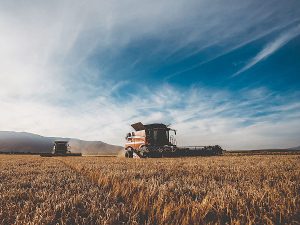UV-C Treatment: Viticulture game changer
A system that combines UV-C light for disinfection could provide chemical free treatment of plant pathogens and diseases such as powdery mildew and botrytis on berry, vine and tree crops.
 Despite the dry conditions, many crops yielded better than expected and harvest conditions were excellent across many regions.
Despite the dry conditions, many crops yielded better than expected and harvest conditions were excellent across many regions.
A recent report from the Agricultural Industry Marketing Initiative (AIMI) highlighted the findings of a survey of New Zealand cereal growers, looking at the size of the 2024 harvest of wheat, barley and oats, divided into milling, malting or feed crops.
The report also looked at sales channels, storage status, carry-over stocks from the 2023 harvest and sowing intentions for the autumn/winter campaign of 2024.
Based on a reporting date of 1st April 2024, overall, harvest yields, averaged of the six crops, were up 4%, from a similar number of hectares (-0.4%), with a net result that saw total tonnages was up 3% compared to last season.
Of the farms surveyed, the 2024 harvest of milling wheat was 100% completed by 1 April, with feed wheat sat at 99.7% complete, malting barley 99%, feed barley 93%, milling oats 89% and feed oats 78% complete by the survey date.
Carry-over stocks (both sold and unsold) of feed wheat and feed barley were higher than in the previous three years, while unsold stocks on hand of last year’s feed wheat and feed barley crops were 2.1% and 2.5% of the 2023 harvest tonnages, respectively.
Stocks of unsold feed wheat from the current harvest are up 46% on unsold stocks at the same time last year, while unsold stocks of feed barley are up 6% as compared to last year. Unsold stocks of milling wheat are up 7%, while unsold stocks of malting barley are down 11%.
Going forward, autumn or winter sowings of feed wheat are predicted to be down 1900 hectares compared to a year ago, with feed barley autumn/winter sowings likely to be down by around 2700ha. Milling wheat autumn/winter sowings may be down by 1000ha, malting barley up by 200ha, milling oats down by 170ha, and feed oats up by 540 ha.
However, these predictions are based mostly on intentions as over all six crops, only 1.2%, which was all feed wheat, had been sown by 1 April 2024.
Looking at the 2023/24 campaign, the weather was generally dry, although some regions experienced above average rainfall events which resulted in redrilling some autumn and spring sown crops, with those later spring crops producing lower yields.
Despite the dry conditions, many crops yielded better than expected and harvest conditions were excellent across many regions. The exception was parts of Southland where frequent rainfall resulted in a prolonged harvest, while several hail events damaged crops near the foothills in Mid Canterbury.
Growers sowing in autumn and winter have reported good conditions, although there have been delays due to the dry conditions in South Canterbury and wet conditions in parts of Southland. Read the full report at www.far.org.nz/resources/aimi-cereals-survey-to-1-april-2024
Virtual fencing and herding systems supplier, Halter is welcoming a decision by the Victorian Government to allow farmers in the state to use the technology.
DairyNZ’s latest Econ Tracker update shows most farms will still finish the season in a positive position, although the gap has narrowed compared with early season expectations.
New Zealand’s national lamb crop for the 2025–26 season is estimated at 19.66 million head, a lift of one percent (or 188,000 more lambs) on last season, according to Beef + Lamb New Zealand’s (B+LNZ) latest Lamb Crop report.
Farmers appear to be cautiously welcoming the Government’s plan to reform local government, according to Ag First chief executive, James Allen.
The Fonterra divestment capital return should provide “a tailwind to GDP growth” next year, according to a new ANZ NZ report, but it’s not “manna from heaven” for the economy.
Fonterra's Eltham site in Taranaki is stepping up its global impact with an upgrade to its processed cheese production lines, boosting capacity to meet growing international demand.

OPINION: Your old mate welcomes the proposed changes to local government but notes it drew responses that ranged from the reasonable…
OPINION: A press release from the oxygen thieves running the hot air symposium on climate change, known as COP30, grabbed your…